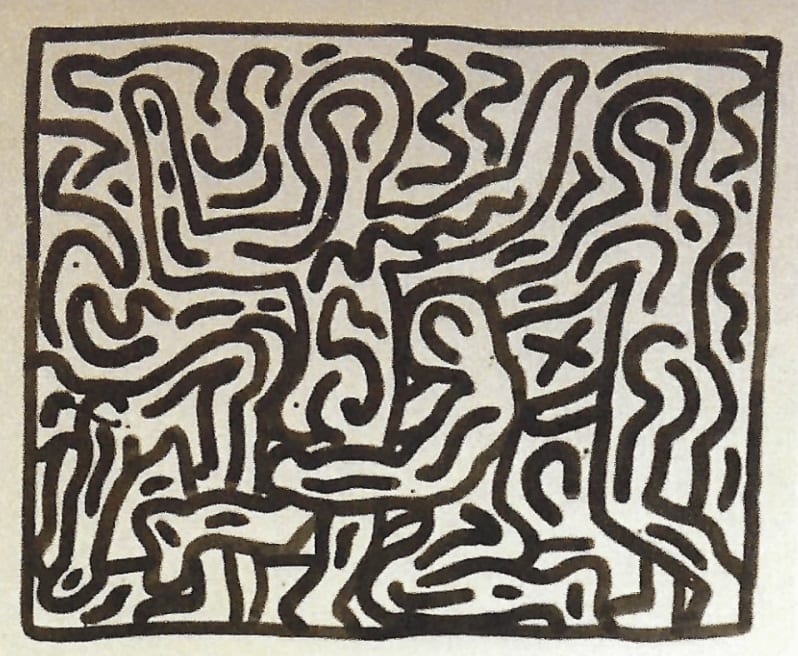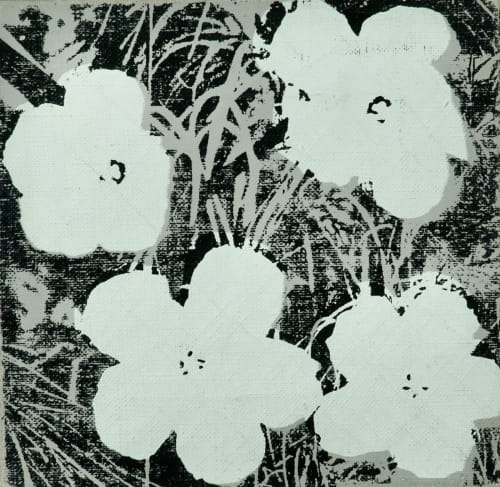Andy Warhol and Keith Haring are two of the most celebrated figures in twentieth-century art, widely recognized for their bold use of color and striking visual language. Warhol’s acid-bright portrayals of celebrities and consumer products and Haring’s primary-colored dancing figures and radiant babies have become synonymous with the Pop and street art movements. Yet when both artists turned to black and white, their work revealed an entirely different register—stripped of color, their images take on a new weight, emphasizing structure, form, and a more introspective emotional tone. The decision to work in monochrome was not a limitation, but a conscious departure from their signature palettes—one that exposed different, often more profound, dimensions of their respective practices.
Warhol’s black and white artworks are particularly arresting because they challenge the very foundations of his Pop aesthetic. In his famous Flowers series from 1964, for instance, the grayscale versions of the hibiscus blossoms offer a somber counterpoint to their exuberant color counterparts. Where color conveys liveliness and immediate appeal, the absence of it draws attention to the formal construction of the image—the lines, the shadows, the composition. These black-and-white flowers feel less like decorative wallpaper and more like meditations on beauty, impermanence, and memory. There is a quietude to them, a kind of elegiac restraint that allows viewers to linger on the surface and the mechanics of reproduction without the sensory distraction of color.
This tonal shift is even more striking in Warhol’s portraits and skull series. Rendered without color, his silkscreen images of Marilyn Monroe or human skulls assume a spectral quality. The grainy half-tones and ink variations—usually masked or softened by vivid hues—are suddenly laid bare, and the image becomes more vulnerable, more human. The glamour of Monroe dissolves into ghostliness, while the skulls feel less stylized and more symbolic of mortality. The monochrome format underscores Warhol’s fascination with repetition and mechanical reproduction, not just as a visual strategy, but as a philosophical inquiry into fame, death, and the fleeting nature of public attention.

Keith Haring’s foray into black and white is equally revealing, though rooted in a different sensibility. From his earliest subway drawings—chalked white on black ad panels in New York’s transit system—to his later Blueprint Drawings, Haring consistently returned to the purity of line and gesture. Unlike his color-drenched canvases or public murals, his black-and-white works are immediate, spontaneous, and stripped to essentials. These drawings are direct extensions of his body and thought, executed with speed and precision, communicating through rhythm and form rather than chromatic variety.
Haring’s visual language—radiant babies, barking dogs, crawling figures—remains instantly recognizable in these works, but their impact shifts. The black lines gain authority and clarity, presenting his lexicon of symbols as a kind of visual grammar. In the absence of color, the viewer’s focus turns to the choreography of lines and the weight of the mark. There is a universality and timelessness to these monochrome works, as if they could be cave drawings or digital icons—unbound by era, yet resonant in every one.
Occasionally, Haring would incorporate a single accent color—often red—into these otherwise black-and-white pieces. But rather than adding decoration, this minimal use of color serves to intensify meaning. In works addressing apartheid or the AIDS crisis, the red becomes a metaphor for urgency, blood, danger. It’s a calculated, targeted intervention that underscores the message rather than diffusing it with aesthetic richness.

The removal of color from the work of Warhol and Haring doesn’t simply shift the visual tone—it transforms the entire framework through which their art is experienced. In Warhol’s case, color often functioned as a form of irony or seduction, luring the viewer into his critique of consumer culture. When that layer is removed, what remains is raw and unadorned. It becomes easier to see the artist’s hand in the process, the smudges of ink, the uneven registration of the silkscreen. The glamour becomes grit, the repetition becomes ritual.
For Haring, monochrome reveals something different—an allegiance to accessibility and communication. His early use of chalk on black posters was born of necessity and immediacy. But even in the studio, he continued to explore the power of black and white to cut through complexity and reach a wider audience. In these works, the emphasis is on clarity, flow, and the direct transmission of idea to image. They remind us that the strength of his work does not lie in color alone, but in the energy and clarity of his line.

This approach aligns with broader democratic and activist principles in both artists’ practices. Warhol, though often perceived as detached or cynical, was deeply engaged with questions of fame, mortality, and cultural memory. His black-and-white works strip away the sensationalism to confront those themes more directly. Haring, ever the activist, saw art as a public good—something to be shared, to provoke, to connect. Monochrome enabled him to communicate rapidly, boldly, and without pretense.
The current exhibition at Guy Hepner Gallery, Pop in Black & White, foregrounds this quieter, more meditative side of Pop Art. By presenting works by Warhol and Haring that forego color, the show invites us to reconsider our assumptions about these artists and their legacies. In an art world that often prizes spectacle, these restrained images offer something radical: the power of simplicity, the resonance of form, and the depth that can be found in visual silence.
What is perhaps most remarkable is how these works continue to feel urgent and contemporary. In an age of visual excess and media saturation, the clarity and immediacy of black and white is more vital than ever. These images cut through noise. They ask us to slow down, to look harder, to consider the structure beneath the surface. Whether through Warhol’s mechanical beauty or Haring’s fluid activism, these monochrome pieces remind us that color, while powerful, is not the only path to meaning.
In stepping away from the saturated palettes that made them icons, Warhol and Haring reveal something deeper—not just about their art, but about the human condition. The world, as they show us, can still be radiant in black and white.
For more information on Andy Warhol signed prints for sale or to buy Keith Haring original art, contact our galleries via info@guyhepner.com. Looking to sell? We can help. Find out how to sell Warhol prints ot sell Haring prints with our London and New York galleries.

